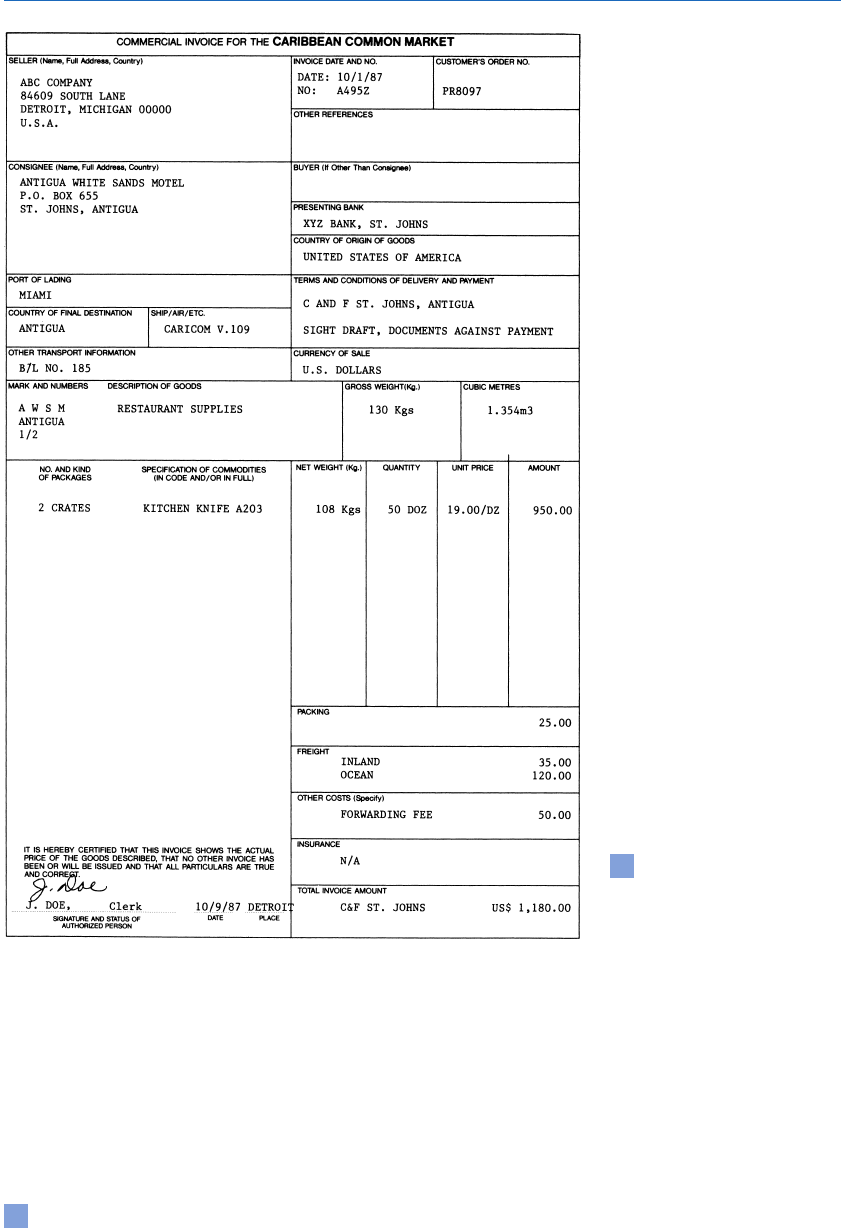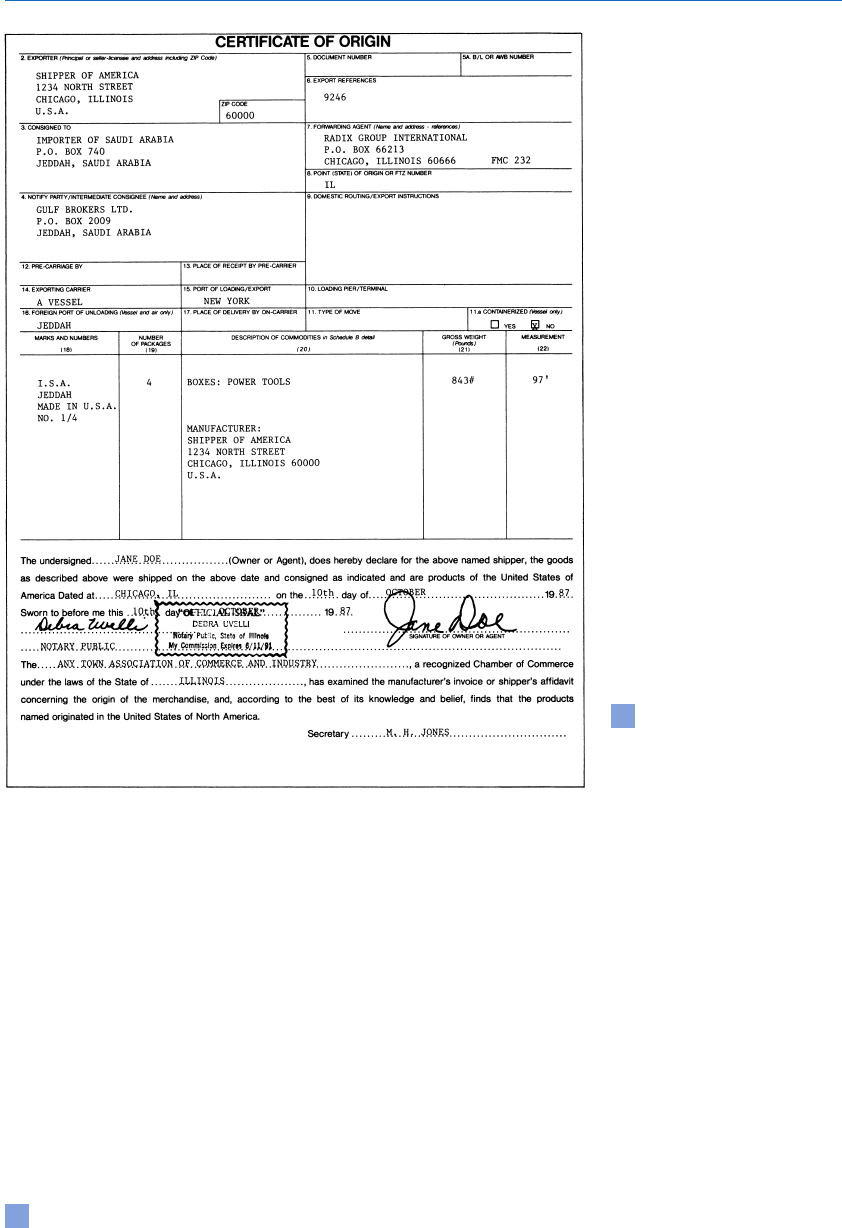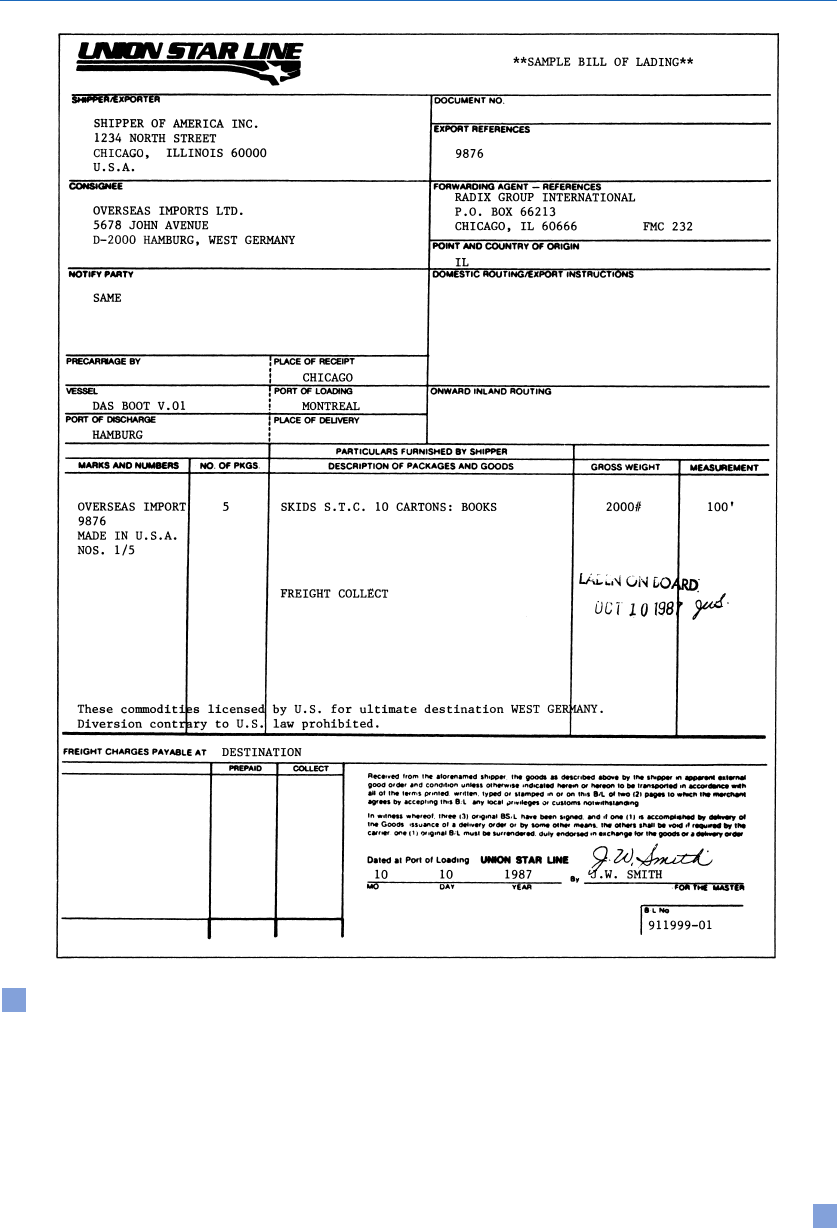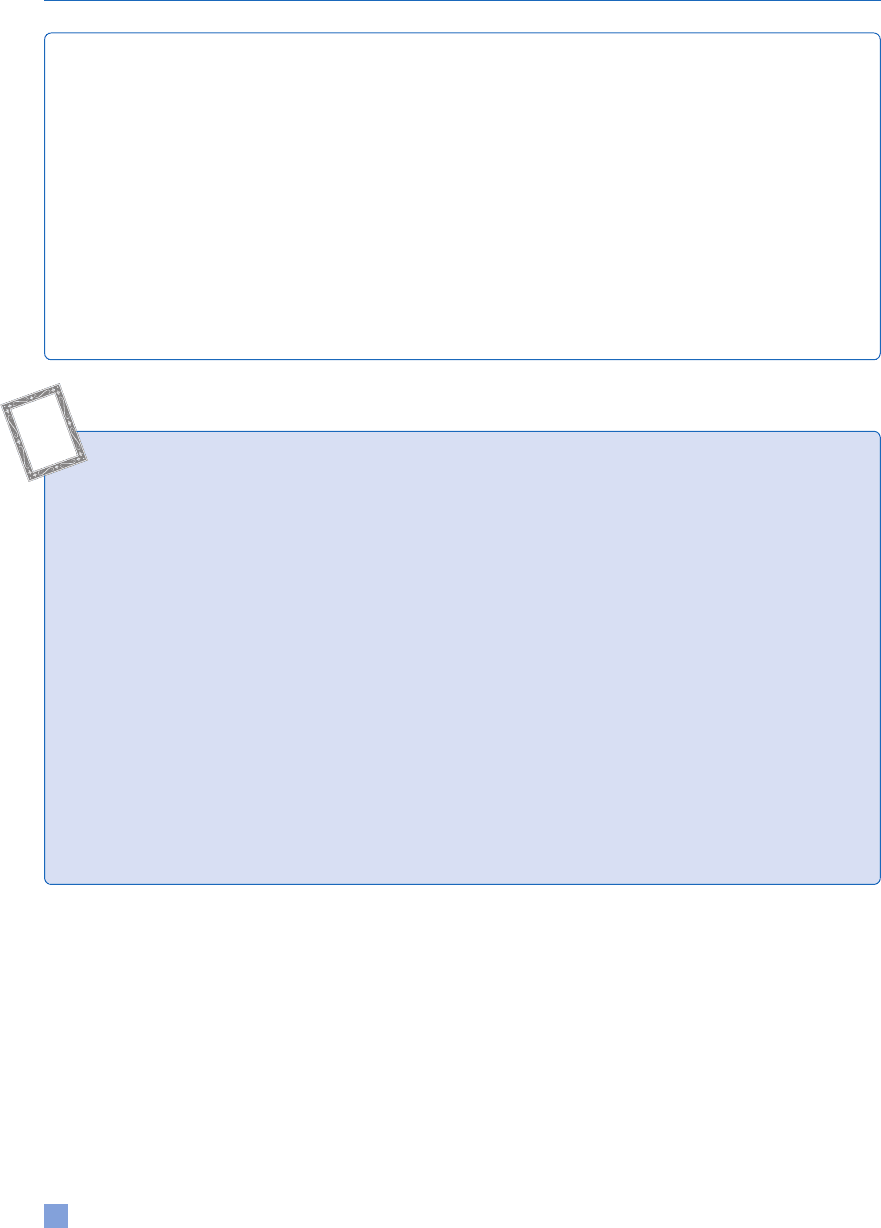Onkvisit S., Shaw J. International Marketing: Analysis and Strategy
Подождите немного. Документ загружается.


the merchandise originated in a certain country.
It assures the buyer or importer of the country
of manufacture. This document is necessary for
tariff and control purposes. Some countries may
require statements of origin to establish possible
preferential rates of import duties under the
Most Favored Nation arrangements. This certifi-
cate also prevents the inadvertent importation of
goods from prohibited or unfriendly countries.
The forms can vary, ranging from a shipper’s own
letterhead certificate to a countersigning by the
Chamber of Commerce (see Figure 13.7). In some
cases, such forms must be visaed by an import-
ing country’s resident consul. For international
use, this document is generally notarized and cham-
berized.
406
PHYSICAL DISTRIBUTION AND DOCUMENTATION
Figure 13.6 Foreign
customs invoice
Source:
Reprinted with permission
of Radix Group International, Inc.

Inspection certificate
An inspection certificate is a document certifying
that the merchandise was in good condition imme-
diately prior to shipment. Many foreign buyers
protect themselves by requiring a shipper’s affidavit
or an independent inspection firm to certify quality
and quantity and conformity of goods in relation to
the order, as well as to ensure that the goods con-
tracted for have actually been shipped.This certifi-
cate is normally prepared by an independent firm
other than the exporter, attesting to the quality or
quantity of goods being shipped.
Special purpose documents
As in the case of an inspection certificate, an
importer may request other special documents,
such as a certificate of weight/measurement and
a certificate of analysis in order to protect the
importer’s interests. A certificate of weight/mea-
surement is issued by an independent party attesting
to the weight or measurement of the merchandise to
be shipped. A certificate of analysis contains an
expert’s report on the findings or grading of the sub-
stance or composition of the product shipped.The
document assures the buyer that the goods are those
that an exporter contracted for shipment.
Insurance certificate
A certificate of insurance is a negotiable document
issued to provide coverage for a specific shipment.
It briefly describes the transaction and its coverage.
Usually, an insurance certificate is issued as an open-
coverage policy to protect any and all shipments and
transportation as long as a certificate is filed for each
shipment. Generally, the policy will cover most
losses sustained during transit. Not restricted only
to ocean shipments is a marine insurance policy,
which covers all modes of transportation.
1111
2
3
4
5
6
7
8
9
10111
1
2
3
4
5
6
7
8
9
20111
1
2
3
4
5
6
7
8
9
30
1
2
3
4
5
6
7
8
9
40
41
42
43
44
45111
407
PHYSICAL DISTRIBUTION AND DOCUMENTATION
Near and Middle East Central America
Saudi Arabia Panama
Kuwait Nicaragua
Lebanon Honduras
Oman Guatemala
Jordan
Bahrain Far East
Syria Philippines (by request)
Yeman Europe and Asia
Iraq Greece (by request)
Iran Spain (by request)
United Arab Emirates Turkey
South America Africa
Colombia (by request) Libya
Argentina
Uruguay Caribbean
Paraguay Dominican Republic
Source:
Reprinted with permission of Radix Group International, Inc.
EXHIBIT 13.2 COUNTRIES THAT REQUIRE A CONSULAR INVOICE

Air waybill
An air waybill is basically a bill of lading issued by
air carriers for air shipments.This transport instru-
ment is not a negotiable document. As a result, a
carrier will release goods to a designated consignee
without the waybill.
Bill of lading
A bill of lading is a document issued to record ship-
ment transportation (see Figure 13.8). Usually pre-
pared by a shipper on the shipper’s carrier’s forms,
this document serves three useful functions. First,
as a document of title, it is a certificate of owner-
ship that allows a holder or consignee to claim the
merchandise described. Second, as a receipt of
goods, it is issued by the carrier to the shipper
for goods entrusted to the carrier’s care for trans-
portation. A bill of lading is thus proof of the
carrier’s possession of the freight. Third, as a con-
tract of carriage, the bill of lading defines the
contract terms between the shipper and his carrier.
The conditions under which the goods are to be
carried and the carrier’s responsibility for the deliv-
ery are specified.
408
PHYSICAL DISTRIBUTION AND DOCUMENTATION
Figure 13.7 A certificate
of origin
Source:
Reprinted with permission
of Radix Group International, Inc.

1111
2
3
4
5
6
7
8
9
10111
1
2
3
4
5
6
7
8
9
20111
1
2
3
4
5
6
7
8
9
30
1
2
3
4
5
6
7
8
9
40
41
42
43
44
45111
409
PHYSICAL DISTRIBUTION AND DOCUMENTATION
Figure 13.8 A bill of lading
Source:
Reprinted with permission of Radix Group International, Inc.

Bills of lading can be issued for inland (overland),
ocean, or air transport. An inland bill of lading is
issued by railroad or truck lines. It authorizes
movement of goods from the shipper’s warehouse
to the port or point of export. An ocean bill of
lading, in contrast, applies to goods shipped by
water and is issued by steamship lines. When the
document is issued by an air carrier, it becomes an
air waybill. In the case of a so-called through bill
of lading, shipment is provided for two or more
transportation modes for delivery to a final destina-
tion. Another kind of bill of lading is the NVOCC,
which is issued by a “nonvessel operator common
carrier” that consolidates freight into a container for
shipping by regular liner vessels.
According to the International Chamber of
Commerce, the bill of lading is acceptable only
when it is marked clean and on board.The bill of
lading is clean when the carrier sees no evidence of
damage to the packing or condition of the cargo.The
cargo thus must be received in good order and con-
dition without exception or irregularity. A bill of
lading is foul when there is indication of damage to
the goods received. For an on-board bill of lading to
be issued, the cargo must be loaded aboard the
named vessel on the specified date of loading. In
comparison, even though a received-for-shipment
bill of lading also mentions a particular vessel, this
document only implies that the goods have been
received by the steamship company. In such a case,
because the goods are not yet loaded on board a par-
ticular vessel, it is possible that the goods may end
up on another vessel instead.
In addition to being classified as clean or foul and
by types of transportation carriers, a bill of lading
can be straight or negotiable. A straight bill of
lading, under international law, is non-negotiable. It
is consigned directly to a consignee rather than to
order. As such, it allows delivery only to the con-
signee or party named on the bill.The carrier must
be certain that the party receiving the goods is actu-
ally the named party. To obtain possession of the
shipment, the foreign buyer simply shows one’s
proof of identity.
A shipper’s order or negotiable bill of lading
is a negotiable instrument that is consigned to order.
When endorsed, it allows transfer of title to the
holder of documents, and delivery can be made to
a named party or anyone designated.
Both the straight and order bills of lading serve
as collection documents.The buyer must pay for the
goods, post bond, or meet other specified condi-
tions before obtaining the bill of lading to claim the
goods.The shipper endorses the bill and presents it
to the bank for collection as evidence of satisfying
the conditions stated in the letter of credit.
CONCLUSION
Moving cargo to an overseas destination is a much
more complex task than transportation of freight
locally. Other than the usual package designed to
protect and/or promote a product while on display,
packing (shipping package) is necessary if the mer-
chandise is to be properly protected during ship-
ment. Because of a greater number of hazards, the
length of time during which the cargo is in transit,
and a carrier’s limited liability, the shipper should
obtain marine insurance. In addition, the shipper
should take necessary packing precautions to mini-
mize any chance of damage. Containerization is
one of several transportation modes that can achieve
this goal.
Cargo cannot move without proper documenta-
tion. There are a huge number of documents that
must be filed to satisfy an exporter’s government
requirements and an importer’s legal requirements.
To compound this problem, the document require-
ments of the various countries are far from being
uniform. The shipper, however, does not have any
option – the shipper simply must submit all required
documents if a cargo is to be moved and if the ship-
per is going to collect payment from the buyer.There
are specialists in cargo movement who can facilitate
the process for a fee. Freight forwarders and cus-
tomhouse brokers work for the shipper and the
importer, respectively. They are capable of taking
over all aspects of physical distribution and docu-
mentation.When the shipper wants to be relieved of
these responsibilities, these intermediaries can help.
410
PHYSICAL DISTRIBUTION AND DOCUMENTATION

QUESTIONS
1 What are some of the hazards associated with the air, water, and land modes of transportation?
2 Explain how the freight rates–density effect can affect the choice of transportation.
3 Distinguish among conference lines, independent lines, and tramp vessels.
4 Distinguish between special coverage and blanket coverage.
5 When is an export license needed?
6 Explain the following documents: SED, dock receipt, invoice (commercial, foreign customs, and consular),
certificate of origin, inspection certificate, air waybill, and bill of lading.
7 Distinguish among these types of bill of lading: clean, foul, straight, and negotiable.
DISCUSSION ASSIGNMENTS AND MINICASES
1 Is there an ideal mode of transportation based on market location, speed, cost, and hazard criteria?
2 What products are suitable for air shipping?
3 Explain how containerization can solve the four packing problems of weight, breakage, moisture, and tem-
perature, and pilferage and theft.
4 What are the functions of a freight forwarder and a customhouse broker? Is it worthwhile to use these
agents?
NOTES
1 Gene R. Tyndall, “We Must Manage Change Before It Manages Us,”
Marketing News
, February 5, 1990,
14.
2 Martin Christopher,
The Strategy of Distribution Management
(Westport, CT: Quorum Books, 1985), 3.
3 John F. Magee, William C. Copacino, and Donald B. Rosenfield,
Modern Logistics Management
(New York,
NY: Wiley, 1985), 193.
4 Mike Moore, “Tariff Reductions Aren’t Enough,”
Asian Wall Street Journal
, June 19, 2001.
5 Rupert Pennant-Rea and Ian G. Heggie, “Commercializing Africa’s Roads,”
Finance & Development
(December 1995): 30ff.
6
Ports of the World: A Guide to Cargo Loss Control
(13th edn) (CIGNA), 46–7.
7 David Ross,“Air Freighting,” in
Handbook of Physical Distribution Management
(3rd edn), ed. John Gattorna
(Aldershot: Gower, 1983), 223–37.
8 “Security as a Trade Barrier,”
Business Week
, December 31, 2001, 36.
9 Overseas Shipholding Group, Inc.,
1993 Annual Report
, 13–14.
10 Charles A.Taff,
Management of Physical Distribution and Transportation
(7th edn) (Homewood, IL: Irwin,
1984), 261.
11
Ports of the World
, 51.
12
Ports of the World
, 52.
13 John Wilson, “Security in Distribution,” in
Handbook of Physical Distribution Management
(3rd edn), ed.
by John Gattorna (Aldershot: Gower, 1983).
14 “Sounding the Alarm in Mexico,”
Business Week
, June 26, 2000, 74.
1111
2
3
4
5
6
7
8
9
10111
1
2
3
4
5
6
7
8
9
20111
1
2
3
4
5
6
7
8
9
30
1
2
3
4
5
6
7
8
9
40
41
42
43
44
45111
411
PHYSICAL DISTRIBUTION AND DOCUMENTATION

15 Magee, Copacino, and Rosenfield,
Modern Logistics Management
, 196.
16 Patterson Brown, “Freight Forwarders, Customs Brokers and Incoterms: Making Exporting Easier,”
Export
America
(November 2001).
17 Paul R. Murphy, James M. Daley, and Douglas R. Dalenberg,“Doing Business in Global Markets: Perspectives
of International Freight Forwarders,”
Journal of Global Marketing
6 (No. 4, 1993): 53–68.
18 “WearGuard Does It Right in Canadian Launch,”
DM News
, April 18, 1994, 22, 43.
19 Jim Robb, “Ask the TIC,”
Export America
(January 2001): 14–15.
20 “US Customs Lays Stress on Secure Cargo,”
Bangkok Post
, November 30, 2001.
21 “Anti-Terrorism Cargo Rules Please Nobody,”
San José Mercury News
, February 19, 2003.
22 “Export Controls,”
San José Mercury News
, February 2, 2000.
23 “Hughes, Boeing to Pay Fines,”
San José Mercury News
, March 6, 2003.
412
PHYSICAL DISTRIBUTION AND DOCUMENTATION

1111
2
3
4
5
6
7
8
9
10111
1
2
3
4
5
6
7
8
9
20111
1
2
3
4
5
6
7
8
9
30
1
2
3
4
5
6
7
8
9
40
41
42
43
44
45111
413
Everyone lives by selling something.
Robert Louis Stevenson
CHAPTER OUTLINE
■ Promotion and communication
■ Promotion mix
■ Personal selling
Personal selling vs. advertising
Varying quality and style of personal selling
Intercultural negotiation
Motivation
Telemarketing
Expatriate personnel
■ Publicity
The nature of publicity
The management of publicity
Negative publicity
■ Sales promotion
The nature of sales promotion
Restrictions
■ Overseas product exhibitions
■ Conclusion
■ Case 14.1 Selling in the EU
■ Case 14.2 AllWorld Corporation
Promotion strategies
Personal selling, publicity,
and sales promotion
Chapter 14

PROMOTION AND COMMUNICATION
The purpose of promotion is both to communicate
with buyers and to influence them. Effective pro-
motion requires an understanding of the process of
persuasion and how this process is affected by
environmental factors. The potential buyer must
not only receive the desired information but should
also be able to comprehend that information.
Furthermore, the information must be sufficiently
potent to motivate this buyer to react positively.
To communicate effectively with someone means
that certain facts and information are shared in
common with that person. Communication is
basically a five-stage process consisting of source,
encoding, information, decoding, and destination
(see Figure 14.1). Encoding is a step that trans-
forms the idea or information into a form that can
414
PROMOTION STRATEGIES
PURPOSE OF CHAPTER
The Fiat example in the marketing illustration below provides clear evidence that a product must be pro-
moted and that advertising is not the only means. A well-rounded marketing plan must include a proper
promotion mix. This mix should not rely solely on advertising – personal selling, publicity, and sales pro-
motion should also be included. This chapter examines the communication process in general as well as
those promotional components other than advertising that are part of the process. Attention is given to the
role of personal selling, both internationally and locally.The pros and cons of employing local nationals for
selling are also discussed.
A section is devoted to the treatment of publicity, examining the principles related to a sound publicity
campaign, with an emphasis on how to deal with negative publicity. A further section investigates the use
of sales promotion and the influence of local regulations on the various sales promotion techniques.
Fiat Automotive S.A. needed a promotion campaign
in Brazil for its redesigned Marea sedan and station
wagon.The company told its agencies that a CD player
was one Marea’s top new features. As a result, the
Impeccable campaign was born.The program focused
on a giveaway of a premium CD containing music
by well-known Brazilian singers (Milton Nascimento
and Gilberto Gil). Direct mailings and consumer
magazines’ inserts were used to distribute the CDs.
Recipients were urged to visit a Fiat dealership for a
chance to win a Marea or concert tickets. They were
required to bring a CD to be played during a test drive.
When the drive was almost over, a salesperson would
skip to the final track which gave an audio code that
could be matched to a printed code located under the
car’s visor. Each person taking a test drive won
concert tickets and could enter a secondary sweep-
stake for a second Marea. More than 22,100 CD
recipients came in for a test drive, exceeding the cam-
paign’s goal by nearly 15 percent. More importantly,
nearly 14 percent of them (about 3000 people) ended
up buying a car. During the promotion period, the
brand achieved an increase of 20 percent in sales.
The campaign also offered sales force incentives.
Fiat aimed its motivation plans at individual sales-
people as well as managers and dealerships as a
whole, thus providing rewards to both an individual
and a team.
Source:
“A Real Gassser,”
PROMO
, January 2002, 58.
MARKETING ILLUSTRATION IMPECCABLE

be transmitted (e.g., written or spoken words). For
a receiver to understand the coded information, that
person must be able to decode these words.
The source can encode and the receiver can
decode only through the experience each has
had.The two large circles in Figure 14.1 represent
the fields of experience of each party. If the
two circles have a large common area, communica-
tion is relatively easy because both individuals
have similar psychological and social attributes.
Communication is more difficult if the overlapping
area is smaller. This is often the case with inter-
national communication. If the circles do not
meet, communication is likely to be impossible; that
is, the sender and the receiver have nothing in
common, and they therefore have an extremely
difficult time understanding each other. Moreover,
“noise” (interference) can easily affect any one of
the five stages, making the effect on the communi-
cation difficult to predict.Thus the sender must be
receiver oriented. The message must consist of
information that the receiver can relate to, and the
information must be encoded with relevant images
and words common to the receiver’s experience and
language.
It is not sufficient for the receiver to be informed
only by the message; the receiver must also be
persuaded to accept the information and to act as
suggested. A promotional message thus must be
designed in such a way that the purchaser reacts
favorably. Effective motivation requires that the
principles of mass persuasion be followed.
1
The first principle is that the message must reach
a person’s sense organs.This may sound simplistic,
yet frequently the message sent is not received by
the intended audience. To ensure reception, the
message must gain the attention of the receiver. If
the right media are not available or if the wrong
message channel is used, the message may never get
to the intended receiver. Furthermore, if the cue is
not appealing, the receiver may never open his or
her senses to the message due to a lack of interest.
Note that what is interesting in one culture may not
be so in another. A message that refers to historical
events in a home country (e.g., July 4) may have
little meaning in a host country.
The second principle requires that the message
should not contradict a person’s cultural norms.
It is possible, though not probable, that a message
that is not consistent with the receiver’s beliefs may
sometimes be potent enough to make the buyer re-
evaluate traditional beliefs. In most cases, such a
message is likely to be rejected, discarded, or dis-
torted. The effective promotional message is thus
one that is accepted as part of the receiver’s attitude
and belief structure.
1111
2
3
4
5
6
7
8
9
10111
1
2
3
4
5
6
7
8
9
20111
1
2
3
4
5
6
7
8
9
30
1
2
3
4
5
6
7
8
9
40
41
42
43
44
45111
415
PROMOTION STRATEGIES
Feedback
Noise
EncodingSource Decoding
Source’s
environmental factors
Receiver’s
environmental factors
Source’s
field of experience
Receiver’s
field of experience
ReceiverInformation
Figure 14.1 The process of communication
